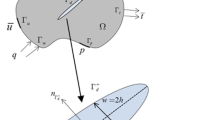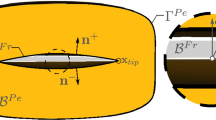Abstract
A finite difference method is proposed for solving the compressible reduced coupled model, in which the flow is governed by Forchheimer’s law in the fracture and Darcy’s law in the surrounding porous media. By using the averaging technique, the fracture is reduced to a lower dimensional interface and a more complicated transmission condition is derived on the fracture-interface. Different degrees of freedom are located on both sides of fracture-interface in order to capture the jump of velocity and pressure. Second-order error estimates in discrete norms are derived on nonuniform staggered grids for both pressure and velocity. The proposed scheme can also be extended to nonmatching spatial and temporal grids without loss of accuracy. Numerical experiments are performed to demonstrate the efficiency and accuracy of the numerical method. It is shown that the parameter ξ has little influence on the fluid flow, and the permeability tensor of fracture has a significant impact on the flow rate in both the surrounding porous and fracture-interface.
















Similar content being viewed by others
References
Bauer, S., Liedl, R., Sauter, M.: Modeling of karst aquifer genesis: influence of exchange flow. Water Resour. Res. 39(10), 371–375 (2003)
Bauer, S., Liedl, R., Sauter, M., Stauffer, F., Kinzelbach, W., Kovar, K., Hoehn, E.: Modelling of karst development considering conduit-matrix exchange flow, in Calibration and reliability in groundwater modelling: coping with uncertainty. In: Proceedings of the ModelCARE’99 conference held in Zurich, Switzerland, 20-23 September, 1999 (2000)
Birk, S., Liedl, R., Sauter, M., Teutsch, G.: Hydraulic boundary conditions as a controlling factor in karst genesis: a numerical modeling study on artesian conduit development in gypsum. Water Resour. Res. 39(1), SBH 2–1–SBH 2–14 (2003)
Espinosa-Paredes, G., Morales-Zárate, E., Vázquez-Rodríguez, A.: Analytical analysis for mass transfer in a fractured porous medium. Pet. Sci. Technol. 31(19), 2004–2012 (2013)
Aulisa, E., Ibragimov, A., Valko, P., Walton, J.: Mathematical framework of the well productivity index for fast Forchheimer (non-Darcy) flows in porous media. Math. Models Methods Appl. Sci. 19(08), 1241–1275 (2009)
Aulisa, E., Bloshanskaya, L., Hoang, L., Ibragimov, A.: Analysis of generalized Forchheimer flows of compressible fluids in porous media. J. Math. Phys. 50(10), 103102 (2009)
Forchheimer, P.: Wasserbewegung durch boden. Z. Ver. Deutsch. Ing 45(1782), 1788 (1901)
Ruth, D., Ma, H.: On the derivation of the Forchheimer equation by means of the averaging theorem. Transp. Porous Media 7(3), 255–264 (1992)
Angot, P., Boyer, F., Hubert, F.: Asymptotic and numerical modelling of flows in fractured porous media. ESAIM: Math. Model. Numer. Anal. 43(2), 239–275 (2009)
Fumagalli, A., Scotti, A.: Numerical modelling of multiphase subsurface flow in the presence of fractures. Commun. Appl. Indus. Math. 3, 1 (2011)
Faille, I., Fumagalli, A., Jaffré, J., Roberts, J.E.: Model reduction and discretization using hybrid finite volumes for flow in porous media containing faults. Comput. Geosci. 20(2), 317–339 (2016)
Hoang, T.-T.-P., Japhet, C., Kern, M., Roberts, J.E.: Space-time domain decomposition for reduced fracture models in mixed formulation. SIAM J. Numer. Anal. 54(1), 288–316 (2016)
Martin, V., Jaffré, J., Roberts, J.E.: Modeling fractures and barriers as interfaces for flow in porous media. SIAM J. Sci. Comput. 26(5), 1667–1691 (2005)
Frih, N., Martin, V., Roberts, J.E., Saâda, A.: Modeling fractures as interfaces with nonmatching grids. Comput. Geosci. 16(4), 1043–1060 (2012)
Loper, D.E.: An analytic benchmark test for karst-aquifer flow. Geophys. Astrophys. Fluid Dyn. 107(5), 587–602 (2013)
Yao, B., Wei, J., Wang, D., Ma, D., Chen, Z.: Numerical study on seepage property of karst collapse columns under particle migration. CMES: Comput. Model. Eng. Sci. 91(2), 81–100 (2013)
Liu, W., Cui, J., Xin, J.: A block-centered finite difference method for an unsteady asymptotic coupled model in fractured media aquifer system. J. Comput. Appl. Math. 337, 319–340 (2018)
Lesinigo, M., D’Angelo, C., Quarteroni, A.: A multiscale Darcy–Brinkman model for fluid flow in fractured porous media. Numer. Math. 117(4), 717–752 (2011)
Ahmed, R., Edwards, M.G., Lamine, S., Huisman, B.A.H., Pal, M.: Control-volume distributed multi-point flux approximation coupled with a lower-dimensional fracture model. J. Comput. Phys. 284, 462–489 (2015)
Ahmed, R., Edwards, M.G., Lamine, S., Huisman, B.A.H., Pal, M.: Three-dimensional control-volume distributed multi-point flux approximation coupled with a lower-dimensional surface fracture model. J. Comput. Phys. 303, 470–497 (2015)
Frih, N., Roberts, J.E., Saada, A.: Modeling fractures as interfaces: a model for Forchheimer fractures. Comput. Geosci. 12(1), 91–104 (2008)
Knabner, P., Roberts, J.E.: Mathematical analysis of a discrete fracture model coupling Darcy flow in the matrix with Darcy–Forchheimer flow in the fracture. ESAIM: Math. Modell. Numer. Anal. 48(5), 1451–1472 (2014)
Liu, W., Cui, J.: A two-grid block-centered finite difference algorithm for nonlinear compressible Darcy–Forchheimer model in porous media. J. Sci. Comput. 74, 1786–1815 (2018)
Li, X., Rui, H.: A two-grid block-centered finite difference method for the nonlinear time-fractional parabolic equation. J. Sci. Comput. 72, 863–891 (2017)
Rui, H., Pan, H.: A block-centered finite difference method for the Darcy-Forchheimer model. SIAM J. Numer. Anal. 50(5), 2612–2631 (2012)
Rui, H., Liu, W.: A two-grid block-centered finite difference method for Darcy-Forchheimer flow in porous media. SIAM J. Numer. Anal. 53(4), 1941–1962 (2015)
Weiser, A., Wheeler, M.: On convergence of block-centered finite differences for elliptic problems. SIAM J. Numer. Anal. 25(2), 351–375 (1988)
Wheeler, M., Xue, G., Yotov, I.: A multipoint flux mixed finite element method on distorted quadrilaterals and hexahedra. Numer. Math. 121(1), 165–204 (2012)
Wheeler, M., Yotov, I.: A multipoint flux mixed finite element method. SIAM J. Numer. Anal. 44(5), 2082–2106 (2006)
Brenner, K., Hennicker, J., Masson, R., Samier, P.: Hybrid-dimensional modelling of two-phase flow through fractured porous media with enhanced matrix fracture transmission conditions. J. Comput. Phys. 357, 100–124 (2017)
Ahmed, E., Jaffré, J., Roberts, J.E.: A reduced fracture model for two-phase flow with different rock types. Mathematics and Computers in Simulation, https://doi.org/10.1016/j.matcom.2016.10.005
Funding
The work is supported by the National Natural Science Foundation of China Grant No. 11771367, the Shandong Provincial Natural Science Foundation No. ZR2019MA049, Shandong Province Higher Educational Science and Technology Program No. J16LI05 and The Hong Kong RGC General Research Fund, Grant No. 15302518.
Author information
Authors and Affiliations
Corresponding author
Additional information
Publisher’s note
Springer Nature remains neutral with regard to jurisdictional claims in published maps and institutional affiliations.
Rights and permissions
About this article
Cite this article
Liu, W., Cui, J. & Wang, Z. A finite difference approximation of reduced coupled model for slightly compressible Forchheimer fractures in Karst aquifer system. Numer Algor 84, 133–163 (2020). https://doi.org/10.1007/s11075-019-00749-z
Received:
Accepted:
Published:
Issue Date:
DOI: https://doi.org/10.1007/s11075-019-00749-z




